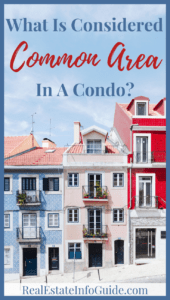As I’ve written elsewhere on the site, a condo is not a style of building, nor is it a particular type of structure. Instead, a condominium is a specific kind of ownership where, when you purchase a condo unit, you actually own the interior of your unit and an interest in all common areas.
What is considered common area in a condominium? Common areas are all elements of the condominium development, which are not documented as being part of an individual unit. A homeowners association usually maintains common areas on behalf of all owners. There may also be limited common areas which are for the use of a particular sub-group of the condominium owners or residents.
If you are considering buying a condo, if you own one already, or if you are considering becoming a renter of a condominium unit, it is vital to know and understand your rights and responsibilities as they pertain to common areas.
 What Is Considered Common Area In A Condo?
What Is Considered Common Area In A Condo?
An often-quoted definition of common area in a condo is:
“In condominium projects, every element of the project is common area except for the improvements located within the interior, unfinished surfaces of a condominium’s perimeter walls, floors, and ceilings.”
Many people struggle with this definition because they do not realize that when you buy a condominium all you actually own, technically speaking, is the airspace within the walls of your unit.
Hence the term “Airspace Condo.”
That is why common area is everything except the “improvements within the unfinished surfaces.” Everything from the paint on the surfaces inwards is your private domain, everything past the paint, or other finish, is common area.
Who Can Use The Common Area In A Condo?
Unless otherwise stated in the Home Owner Association rules, more appropriately called the Declaration of Covenants, Conditions, and Restrictions (CC&Rs), all residents and unit owners have an equal right to use all common areas in a condominium development.
In reality, none of your neighbors are likely to pop round, demanding to exercise their rights to enjoy the common areas which house the pipes behind your kitchen.
But in theory, in some developments they could.
While, generally speaking, if it’s outside a unit, it is a common area, and you can use it, the majority of HOA’s define usage rights of common areas more clearly.
For example:
- Some leisure facilities, such as a swimming pool or gym, might be restricted to owners and residents only. In cases such as this, a guest visiting your unit would be unable to use the facilities or, alternatively, they may be required to obtain specific permission for the Home Owners Association.
- Access to areas such as the roof, furnace room, and the exterior of the building may be restricted for health and safety reasons.
- If pets are allowed in the development, there could be rules around the common areas in which they may or may not be exercised.
Are There Restrictions To What I Can Do In A Common Area?
In the same way that the Declaration of Covenants, Conditions, and Restrictions will define who can use the common areas in a condominium, they may also place restrictions on what you can do in a common area.
These restrictions can take many forms. For example, some of the limitation to what you can do in a common area I found during my research were:
- One more substantial condominium development did not allow residents or homeowners to hold garage sales. The exception to this was on one weekend a year when the gates were opened so members of the public could enter the community and attend the communal garage sale. Also, there was a dress code for those homeowners who chose to participate – they were required to wear beige shorts and a white polo-style tee-shirt.
- A large condominium building in one of the larger metropolitan cities made changes to their Declaration of Covenants, Conditions, and Restrictions, banning pet ownership in the condo. Several existing tenants had dogs and won a court case which allowed them to keep their pets. As a consequence, the homeowners association, which had recently renovated the elevators and the lobby banned pets from these areas. Instead, pets were restricted to the service elevators and entrances.
- Your front door is, technically speaking, a common area. As such, it is not unusual for HOAs to place restrictions on the color you can paint your front door or the door furniture you can install.
- In a similar vein garden furniture, shutters, awnings, and other items on the outside of a property may have restriction on use, style, or whether they are allowed at all.
In fact, the list of potential restrictions are endless and are only bound by the imagination of the homeowners association.
This is the reason that it is critical you examine a copy of the Declaration of Covenants, Conditions, and Restrictions before placing an offer on a home in a condominium. If that is not possible, put a clause in your offer which makes it subject to your receiving and approving of a copy before the sale goes forward.
How Are Common Areas In A Condo Maintained?
All common areas in a condo are the responsibility of the homeowners association, and it is the homeowners association who must schedule and pay for all maintenance.
The details of this process can vary from condo to condo so, just because it is done in a particular way in one place, doesn’t mean it will happen the same way in another.
However.
Maintenance is paid for in the same way by every homeowner’s association – through the homeowners association fees.
To set the fees, each year, the homeowner association calculates how much they will need in the coming year to run the condominium. This includes the costs of:
-
- Electricity, water, gas, internet, etc. The exact details of what is paid for by the homeowners association will depend on the condo itself, but a good rule of thumb is that if it has to reach your unit through the walls, then it is likely the homeowners association will provide and divide the cost equally between the residents.
- Property taxes. Depending on where in the the country the condo is located there may be more than one level of government which levies a property tax on the condo. Again, this cost is divided equally between all residents.
- Regular maintenance. HOA’s are responsible for identifying all of the routine maintenance tasks which are required and for ensuring they happen.
- Scheduled upgrades.
- Unexpected repairs.
- Insurance.
They should also include an amount to go into a “capital investments fund” which is like a savings account used to pay for more expensive, less frequent items such as new windows or a new roof.
Regular maintenance is carried out by either a contractor or an onsite staff member, and just as the homeowners association are responsible for scheduling and paying for the maintenance of the condo, they are also responsible for ensuring work is carried out to an acceptable standard.
Therefore, if someone is living in a condominium and maintenance is not happening as they were led to believe it would be, they should contact the chair of the homeowners association.
What Is A Limited Use Common Area?
In some condominium developments, especially the larger ones that have many building and leisure facilities, you may come across limited use common areas.
These common areas are for the exclusive use of a particular group of residents within the larger condominium.
These areas are usually created to either limit the number of people who can access relatively small areas or provide additional amenities for a small group of residents who will then be charged a higher homeowners association fee to pay for the privilege.
Examples of a limited use common area might include:
- A patio which is only accessible from a specific floor of the building.
- Play equipment in a children’s playground which is intended only for the use of the families in the units immediately surrounding it.
- Specific roadways in a larger development which may only be used by residents who live on those roads and their visitors.
Final Thoughts
While all areas of a condo, which are not explicitly documented as being part of an individual unit, are, technically speaking common areas, that doe no automatically mean that every homeowner or resident has an equal right to access and use them.
Instead, for practical purposes think of the common areas as the places where it is easy to go.
If there are no restrictions placed on entry or you can reasonably gain access without having to ask permission, then it is likely a common area.
You should also think of a common area as a place where you cannot make any changes or repairs without asking the homeowners association for their approval.
About The Author
 Geoff Southworth is the creator of RealEstateInfoGuide.com, the site that helps new homeowners, investors, and homeowners-to-be successfully navigate the complex world of property ownership. Geoff is a real estate investor of 8 years has had experience as a manager of a debt-free, private real estate equity fund, as well as a Registered Nurse in Emergency Trauma and Cardiac Cath Lab Care. As a result, he has developed a unique “people first, business second” approach to real estate.
Geoff Southworth is the creator of RealEstateInfoGuide.com, the site that helps new homeowners, investors, and homeowners-to-be successfully navigate the complex world of property ownership. Geoff is a real estate investor of 8 years has had experience as a manager of a debt-free, private real estate equity fund, as well as a Registered Nurse in Emergency Trauma and Cardiac Cath Lab Care. As a result, he has developed a unique “people first, business second” approach to real estate.
Check out the Full Author Biography here.
